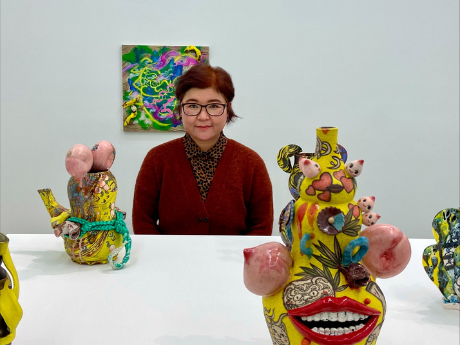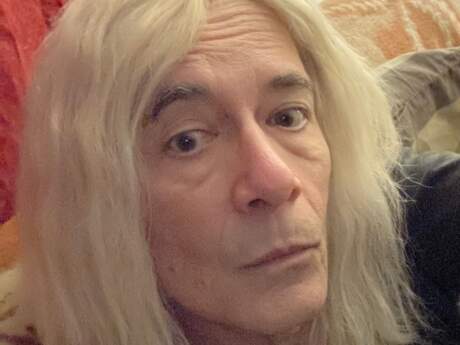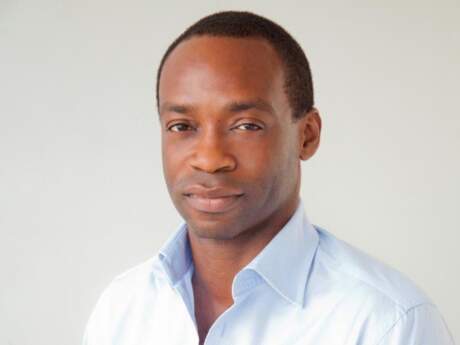Stopping By
Stopping by with Jiha Moon

During this extraordinary moment in time, we asked writers, musicians, curators, and innovators to reflect on influence, memory, language, shared spaces, and the power of poetry to bring us together.
Jiha Moon is from Daegu, Korea, and lives and works in Atlanta, Georgia. Moon's work has been acquired by museums around the country, including The Asia Society in New York City, The High Museum of Art in Atlanta, The Mint Museum of Art in Charlotte, The Hirshhorn Museum and Sculpture Garden in Washington, DC, and The Virginia Museum of Fine Arts in Richmond. She is a recipient of Joan Mitchell Foundation’s Painter and Sculptor’s Award and her mid-career survey exhibition, “Double Welcome: Most everyone’s mad here,” organized by Halsey Institute of Contemporary Art and Taubman Museum, has toured more than 15 museums around the country. Moon teaches painting and drawing at Georgia State University in Atlanta
What is the last thing that moved you?
When my father passed away two years ago, I couldn’t attend his funeral in Korea due to the Covid travel ban. I was lucky that I got to visit him right before the end, but it was painful that I couldn’t be with my family for his funeral. While I was going through a tough time, a close friend sent me a handwritten poem: Mary Frye’s “Do not stand at my grave and weep.” I love the poem so much that I have read it repeatedly. It got me through those tough days.
What is a piece of art that changed or greatly influenced your life?
I remember I was shaken away when I saw the magnificent Vincent Van Gogh painting The Road Menders (1889) at The Phillips Collection some years ago when I visited DC. It was such an intense experience. The painting was glowing in the room—illuminated from within like some sort of spectral phenomena. The painting has predominant light lemon yellow and jade green hues with firm yet fluid brush strokes as if the artist painted the day before. His color and brushwork have moved my emotion so much, and I still think about the moment of shock. Sometimes, I wonder if this has had an unconscious influence on my own Yellowave series after all. Although I never thought of making a connection with my work to his directly, I often consider how the impact of bold color and brushwork can create big waves of emotions.
What is your first memory of poetry?
The Korean poet Yun Dong Ju’s “Prologue” is the one that I remember the most. It’s my mom’s favorite poem, and I remember she sang that poem often and acted it out in front of me and my siblings for fun. Later, I learned in school about how the poet underwent horrific hardship during the Japanese colonial occupation of Korea. “Prologue” has become all the more heartfelt and vivid as storytelling to me since. In my mind, the poem sounds much like a monologue on a lonely stage without an audience and self-reflecting. A few years ago, I found out they made a Korean film, Dongju (2016, directed by Lee Joon-Ki) which became a full experience for me when I watched it.
How has this last year changed you and what is something that you will take with you into a post-pandemic world?
Last year was intense preparing my solo show, Stanger Yellow at Derek Eller Gallery in New York City, while I returned to instruct in person (I am a full-time lecturer teaching painting and drawing) at Georgia State University, after months of remote teaching. I went to work every day masked up, taking public transportation to get to and from work. Seeing my students and working with them every day was great comfort but also challenging at the same time. After we got our vaccines completed, I went to visit friends and galleries that I work with. I took my thirteen-year-old boy on my road trip, and in July we visited my childhood friend in Hawaii. Through safe and successful trips to Miami and Hawaii during this time, I gained much confidence. I want to show my teenage boy that we need to live full and active lives despite the current situation.
I had Covid last winter despite having gotten the vaccine, but I kept working and finished prepping my show. The beginning of the dreaded “Omicron surge” happened to coincide with the opening of my show at Derek Eller Gallery. Honestly, I tried not to read the news but to just focus on my studio work. I went to New York for my opening and reunited with old friends and met new ones. People in NYC were calm and enthusiastic and most of all, they were looking at my work. We were all wearing masks, but no one complained. The show was well-received, with great reviews, and I was proud of what we were able to accomplish despite the crazy overall situation. Of course, I’ve learned for sure to focus on the present moment.
Who or what is your greatest creative influence?
I would say that it is my Korean family. None of my family members are visual artists but they are the most creative people that I know. Above all I would like to say that my 94-year-old grandmother is the biggest influence. She still makes interesting stuff and has lots of her personal projects going on. She has shown me how to put things together using the scrap fabrics that she has been collecting since she was young. She makes bojagi (small Korean quilts) and house goods and has a deft hand for gardening and cooking. The only time she lies down is when she takes a nap or goes to bed at night, she is the busiest person in the world. She is humble but has a badass unapologetic attitude with full force when she needs to. When I lived in Korea for about 26 years before coming to the US, she was always around me. I learned most of my life skills and aesthetics from her. If she saw something cute at the market, she would come home and try to make it herself instead of buying it. Grandma Moon is full of life.
If you were to choose one poem or text to inscribe in a public place right now, what would that be? And where would you place it?
Since I am from Atlanta, GA I would like to remind Martin Luther king’s quote: “We must discover the power of love, the power, the redemptive power of love. And when we discover that we will be able to make of this old world a new world. We will be able to make men better. Love is the only way.” I would like this quote on every billboard as a sign project.
What do you see as the role of art in public life at this moment in time?
Despite all the crazy technology interrupting conventional art viewing, I still want to say that I am an object lover. I love to visit museums to dig deep, physically looking at the marvelous paintings and exquisite art objects that people have made over the ages. I hope that curators, educators, and art enthusiasts can find a better way to reintroduce art to the younger generation. Teach them to look at art with wonder and joy, and discover how humanity is embedded in these objects in a slow and meaningful way—in stark contrast with the frenetic nature of this fast, attention-shifting world we live in.
What do you want people to take away from your work?
Emotion, love of color and visual sensation that connect to the meaning of life. Then, bring their storytelling to understand the world around us.
Are you working on anything right now that you can tell us about?
I have several projects going on. In this summer my first public project, a mural, will be up in downtown Atlanta near Georgia State University. I am working on a solo exhibition this coming November with Mindy Solomon Gallery in Miami. I will be at the Amory show in New York this fall with Derek Eller Gallery, and an upcoming solo museum project that I can’t yet mention. And I have my debut solo show in Los Angeles in 2023 with Shoshana Wayne Gallery.
What are you hopeful for in 2022?
I am hopeful for people to be more hopeful and less cynical or pessimistic this year.


